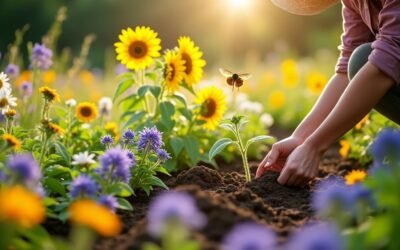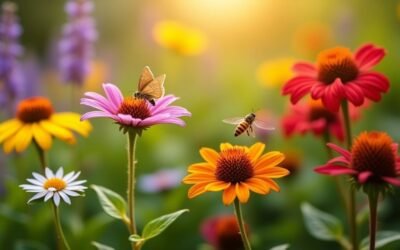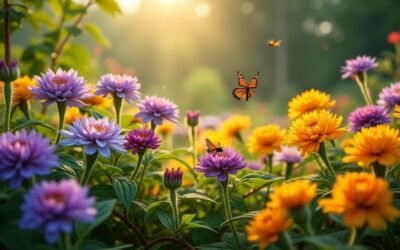Hummingbirds are particularly attracted to flowers that boast bright colors—especially red, orange, and pink—and possess tubular shapes, enabling easy access to their rich nectar. Such floral characteristics not only serve to allure these remarkable pollinators but also guarantee a consistent nectar supply throughout various seasons. For ideal hummingbird attraction, these blooms should ideally thrive in full sun, requiring at least six hours of sunlight daily, while well-drained loam soil enriched with organic matter provides essential moisture retention. By incorporating these unique plants into gardens, one can enhance biodiversity, ultimately inviting more of nature's delicate marvels into their spaces. More awaits about selecting the best flowering plants.
Main Points
- Tubular-shaped blooms enable easy nectar access, making them more attractive to hummingbirds.
- Brightly colored flowers in shades of red, orange, and pink significantly draw hummingbirds.
- High nectar production is essential for enticing hummingbirds to visit and feed on flowers.
- Perennial varieties provide a reliable nectar source throughout different seasons for hummingbirds.
- Combining flowering plants with feeders enhances nectar availability and frequent hummingbird visitation.
Introduction
In the vibrant world of horticulture, certain flowers possess unique characteristics that irresistibly allure hummingbirds. Commonly known by their popular names, these plants, which include agastache and bee balm, feature tubular shapes and bright colors that cater to the feeding habits of these small avian wonders. Tubular-shaped flowers with high nectar production are essential for luring these birds to gardens. Understanding the scientific names and specific traits of these flowers not only enhances garden aesthetics but also plays an essential role in supporting the ecological balance, as these beautiful creatures rely on these plants for sustenance and survival. Additionally, hummingbirds are highly social and often gather at feeders and flowering plants, making gardens a vibrant hub of activity.
Common Name
Hummingbirds are often fascinated by vibrant flowers, especially those with rich nectar. These tiny birds exhibit a strong preference for tubular-shaped blooms, which allow them to access nectar conveniently. Bright colors, particularly red and orange, are highly attractive, yet other hues like pink, purple, and blue also draw their attention. Effective nectar production is crucial; the more nectar a flower offers, the more likely it's to entice these enchanting creatures.
When selecting plants for a hummingbird habitat, perennial varieties are often favored due to their reliable nectar supply throughout the seasons. Annuals, like Cuphea and Petunia, maintain appeal with their continuous blooming patterns. Additionally, incorporating native plants, such as the renowned Hummingbird Flower (Epilobium californica), enriches the local ecosystem while providing sustenance. The Hummingbird Plant provides essential color during the fall season, attracting these birds when they need nourishment the most. Furthermore, generally hardy plants ensure that the hummingbirds have access to blooms over multiple years.
To support these migratory visitors, it's important to choose plants with staggered bloom times, ensuring a steady nectar source.
In cultivating a thriving environment, gardeners should prioritize full sun exposure and consistent watering to bolster both blooming and nectar production, creating a haven for hummingbirds and enhancing garden vitality.
Scientific Name
Numerous flowers that attract hummingbirds belong to specific scientific classifications, highlighting the intricate relationship between these plants and their pollinators. The scientific classification starts with the Kingdom Plantae, which encompasses all plants, and further narrows down through clades such as Tracheophytes, angiosperms, eudicots, and eventually Rosids, where many hummingbird favorites reside.
Among the flowers essential to hummingbirds, the Onagraceae family features the genus Epilobium, particularly Epilobium canum, which boasts taxonomic synonyms like Zauschneria cana and Zauschneria californica. Other genera include Kniphofia, which offers varieties like the Poco™ Orange Hot Poker, and Penstemon, known for its Harlequin™ Purple Beardtongue. To attract these delightful birds, gardeners should strive to incorporate a diverse range of hummingbird-friendly plants that provide consistent nectar sources. Additionally, Epilobium canum's drought-tolerant nature makes it an ideal choice for low-water landscapes, further supporting the ecosystem. Notably, early bloomers like the Common Cowslip can enhance the overall attractiveness of gardens for various pollinators, including hummingbirds.
While not all species have established taxonomic synonyms, names like Salvia, Aloe, and Hesperaloe belong to respective families that contribute to this vibrant ecosystem.
Understanding these scientific classifications enriches appreciation for these flowers, allowing gardeners and nature enthusiasts to cultivate environments fostering hummingbird visitation. Such knowledge underscores the critical role these plants play in supporting biodiversity, ultimately creating lush habitats for these agile pollinators.
Overview
Creating a vibrant garden filled with flowers that attract hummingbirds can transform outdoor spaces into lively habitats. By understanding hummingbird behavior and their nectar preferences, gardeners can select the ideal plants for their backyard oasis.
Hummingbirds are particularly fond of brightly colored blooms, especially those in shades of red, orange, and pink. Their long, slender beaks allow them to access the nectar from tubular or trumpet-shaped flowers, which are especially appealing. Additionally, providing a combination of feeders and flowers ensures that these birds have consistent food sources throughout their stay. Incorporating plants like Salvia darcyii, known for its long spikes of orangy-red flowers, can significantly extend the blooming period for hummingbirds. The presence of early-spring blossoms also attracts pollinators, enhancing the diversity in garden habitats.
For a consistent food supply, planting a variety of species with staggered bloom times is crucial. This guarantees that from early spring to late fall, hummingbirds will find an abundant source of nectar. Incorporating annuals like zinnias, perennials such as salvia, and ornamental vines grants them a rich tapestry of options.
Strategically placing these flowers to maximize visibility and accessibility adds to the garden's allure. Maintaining rich, moist soil while avoiding harmful insecticides preserves the delicate balance of the ecosystem—since hummingbirds also consume small insects as part of their diet.
Ultimately, this thoughtful planning creates an enchanting environment, inviting these fascinating creatures to thrive.
Key Features
When considering flowers that attract hummingbirds, key features such as growth size, appearance, and flowering season play vital roles in their appeal. Typically, these plants vary widely in height, from modest perennials under a foot tall to towering annuals that can reach several feet, each offering unique visual aesthetics and bloom characteristics throughout the seasons. Understanding these dimensions helps gardeners select the best varieties that not only complement their landscapes but also provide essential nourishment for these agile pollinators. Additionally, many of these plants, like Cuphea and Hummingbird Mint, showcase drought and heat tolerance once established, making them suitable for diverse gardening conditions. Moreover, many of these flowers, such as Bouvardia, produce fragrant, tubular corollas that further attract hummingbirds with their vibrant colors.
Growth Size
The growth size of flowers that attract hummingbirds varies greatly among species, enhancing the garden's visual appeal. Height variations markedly influence how these botanical wonders coexist in landscapes, making plant spacing a vital factor for ideal growth.
For instance, the striking Cardinal Flower reaches heights of 3 to 4 feet, while the more delicate Hosta can grow as low as 6 inches to a generous 30 inches. This diversity allows gardeners to create layers of color and texture. Additionally, selecting plants based on hummingbird preferences increases the likelihood of maximizing visits. Many of these flowering plants, such as Musk Mallow, also attract essential pollinators, enriching the garden ecosystem.
Perennials such as Penstemon span heights from 1 to 4 feet, providing an excellent backdrop for shorter blooms like Bee Balm, which stands proudly at 2 to 4 feet tall. Annuals, including Zinnia, exhibit heights from 6 inches to an impressive 4 feet, emphasizing the need for adequate spacing to maintain airflow and combat mildew.
Vining plants, like the Trumpet Honeysuckle, dramatically extend vertical growth, often reaching up to 12 feet, effectively utilizing vertical space. The combination of these height variations enables gardeners to cultivate a dynamic environment that not only attracts hummingbirds but also captivates the eye, enriching the garden's ecological tapestry. Incorporating diverse flower species can further enhance the stability of nectar sources throughout the seasons.
Appearance
Vibrantly colored flowers consistently draw hummingbirds into gardens, making appearance a critical aspect of their attraction. Hummingbirds are particularly enchanted by bright hues, especially shades of red, orange, and pink. Red flowers, favored by species like the ruby-throated hummingbird, stimulate a strong visual interest, while orange and yellow blossoms, seen in jewelweed, also play a significant role.
Additionally, pink flowers, especially those from the Heuchera genus, often beckon these avian visitors. A diverse selection of native plants supports these vibrant creatures and also contributes to ecological benefits like attracting local pollinators. For instance, the Guelder Rose (Viburnum opulus) serves as an attractive option, providing both nectar-rich flowers and bright red berries for local wildlife.
In addition to flower colors, the shapes of these blossoms are equally important. Tubular-shaped flowers cater to hummingbirds' long, slender beaks, enabling easy access to nectar. Trumpet-shaped varieties, such as trumpet vine and fuchsia, showcase a design specifically tailored for hummingbird feeding habits. Furthermore, bell-shaped flowers, like those of the bee balm, enhance this interaction as well.
While the colors and shapes of flowers undeniably attract hummingbirds, it's crucial to remember that these birds rely primarily on their eyesight rather than scent to locate these nectar-rich sources. As a result, vibrant appearances serve as significant signals to hunters of sweet energy, ensuring successful pollination and sustaining the delicate balance of the ecosystem in the face of diverse floral resources that are essential for their support along migration routes.
Flowering Season
As spring blossoms into view, various flowers begin to emerge, playing a significant role in attracting hummingbirds. Early spring blooms like Virginia bluebells and Eastern columbine debut, providing essential nectar for these migratory birds returning after a long journey. Remarkably, Eastern columbine's intricate red and yellow flowers are particularly alluring, emitting a tantalizing aroma that draws attention. Notably, plants like tormentil, rich in tannins, can also attract pollinators, contributing to a diverse garden ecosystem. Blue Eryngo, with its striking steel-blue flower heads, is also known to attract various pollinators, including hummingbirds.
Transitioning into late spring and summer, an array of vibrant flowers unfolds. Trumpet honeysuckle, characterized by its tubular shape, offers a continuous nectar supply from late spring through summer, essential as hummingbirds ramp up their activities. This nectar source is critical for their survival and supports their high-energy lifestyle, while including native perennial flowers in gardens ensures seasonal benefits and low maintenance.
Alongside, scarlet gilia and blue false indigo further enhance the summer nectar landscape, ensuring these agile creatures have a steady source of nourishment. The flowering traits of these plants, designed for bird pollination, include plentiful nectar and pollen, maximizing hummingbird visits. Indeed, hummingbird-pollinated flowers often exhibit higher pollen counts than those reliant on insects.
As these beautiful blooms thrive throughout the flowering season, they create an intricate ecosystem that supports hummingbirds, enabling these fascinating birds to fulfill their energetic feeding needs and sustain their vibrant lives.
Growing Requirements
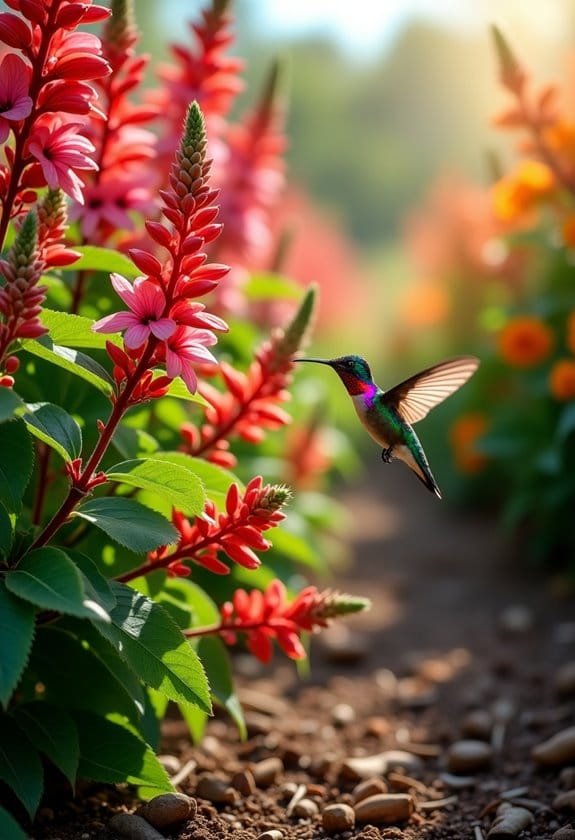
When cultivating flowers that attract hummingbirds, understanding their growing requirements is critical.
These vibrant creatures thrive in conditions that offer full sun exposure for six or more hours, favoring well-drained loam soil enriched with compost. Additionally, maintaining appropriate moisture levels guarantees that the plants not only flourish but also provide a consistent source of nectar throughout the blooming season. Including a variety of plants that feature nectar-rich flowers can further enhance the garden's appeal to hummingbirds.
Light
Light plays an essential role in the growth and blooming of flowers that attract hummingbirds. Most of these vibrant plants thrive in full sun, requiring a minimum of six hours of direct sunlight daily. For instance, Bouvardia, Pentas, and Petunia flourish under bright conditions, showcasing their splendor only when bathed in sunlight.
However, some species, like Torenia and Cat Whiskers, exhibit partial shade tolerance, preferring conditions with filtered sunlight or light shade, which can bring out their unique hues without overwhelming them. Essential pollinators like hummingbirds are more attracted to gardens with a diverse range of blooming plants basking in sunlight.
The intensity of sunlight matters considerably; too much direct sunlight can hinder growth, while inadequate light stunts blooming and attracts fewer hummingbirds. For those cultivating hummingbird-friendly gardens indoors or in shaded areas, artificial lighting can effectively supplement natural light.
Grow lights can mimic sunlight's specific wavelengths, ensuring plants receive the necessary light spectrum for ideal growth. Ultimately, understanding light requirements is paramount, as gardens that provide consistent, quality sunlight not only enhance plant health but also create bountiful nectar sources that entice hummingbirds.
Soil
Creating a thriving environment for hummingbirds goes beyond just providing sufficient sunlight; the soil conditions also play an essential role in supporting vibrant flowers. Preferred soil types include loose, well-drained loam, clay, and sandy soils, each offering distinct advantages depending on the native plants chosen. Maintaining well-drained soil prevents waterlogging, which can detrimentally impact root systems. Additionally, these native plants are specifically chosen to attract hummingbirds, providing ample nectar throughout the blooming season.
Moisture levels vary with specific plants, appealing to garden designs that emphasize consistency. While native plants can thrive in various moisture conditions—often necessitating no additional watering once established—some designs benefit from consistently moist soil, especially near ponds or low-lying areas. This adaptability underscores the significance of selecting plant species compatible with the chosen soil conditions. Additionally, choosing nectar-rich plants enhances the attractiveness of the garden for hummingbirds.
Moreover, proper soil preparation, including adding organic matter, enhances soil structure and fertility, enabling robust growth. For best results, planting in masses, rather than in rows or random placements, creates a striking visual impact while fostering a supportive ecosystem.
Flat to slightly sloped terrain provides stability, while the right balance of sun and shade guarantees that diverse flowers will flourish, attracting the lively presence of hummingbirds to any garden designed with these principles in mind.
Water
Hummingbirds require constant access to fresh, clean water for bathing and drinking, making water sources an important component of any garden designed to attract them.
To create an inviting habitat, gardeners should incorporate various water features, such as small bird baths or gentle drip fountains. Moving water, particularly from fine misting devices or gentle sprays, enthralls these birds, drawing them to the garden. This is crucial because hummingbirds are critical for the food sources of other wildlife, which underscores the importance of maintaining a healthy ecosystem. Notably, these tiny birds require constant feeding to sustain their high energy levels, further emphasizing the need for a diverse and nourishing environment. Additionally, ensuring that these habitats feature plants like Silverweed can enhance the overall appeal due to its vibrant yellow flowers, which attract hummingbirds while providing essential nectar. Pyracantha species, known for their ornamental beauty, also provide berries that can feed a variety of birds.
For ideal water placement, situate these features in shaded areas to prevent rapid evaporation and maintain water freshness. It's essential to position the water sources near flowering plants; doing so creates a harmonious environment where hummingbirds can easily access both nectar and hydration.
Additionally, ensuring enough space around the water feature allows these agile creatures to hover and maneuver safely.
Maintaining the water features is fundamental, as algae and bacterial growth can deter hummingbirds. Regularly changing the water keeps it pure and free from contaminants.
Avoid placing the features near potential predators, ensuring the wellbeing of the birds.
Temperature
Temperature plays an essential role in the growth and blooming of plants that attract hummingbirds. Gardeners must consider temperature fluctuations and extremes when selecting suitable species for their regions.
In colder climates, such as USDA Zones 1-4, plants like the Cardinal flower and the Trumpet vine exhibit remarkable hardiness, thriving even as temperatures plunge to -50°F (-46°C) or hover around -20°F (-29°C). These plants often rely on insulating snow cover to survive harsh winters, showcasing their resilience. Additionally, Water Avens(Geum rivale) has adapted to thrive in moist, cooler environments, providing a vibrant option for these regions. Germander Speedwell(Veronica chamaedrys) is another option that flourishes in well-drained soils, enhancing garden biodiversity. Hardiness Zone Map helps gardeners identify the most suitable plants for their area. Additionally, hummingbirds' seasonal migration patterns emphasize the need for early spring blooms to support their energy requirements upon arrival.
Conversely, warmer climates, especially in Zones 8-10, experience longer growing seasons and milder temperatures, allowing tropical varieties like Bouvardia and Coral Honeysuckle to flourish. These plants bloom year-round, reveling in the balmy conditions that invite an abundance of hummingbirds.
In such regions, the ideal blooming temperatures generally range around 50°F (10°C).
Ultimately, understanding the thermal environment—whether dealing with extreme cold or temperate warmth—enables gardeners to cultivate a mesmerizing array of hummingbird-attracting flora that thrives in harmony with their local climate.
Therefore, awareness of temperature dynamics is crucial for promoting vibrant gardens teeming with life.
Pollinator Criteria
When considering the criteria that attract hummingbirds, one must pay attention to specific floral characteristics and pollination methods.
Flowers boasting vibrant colors, particularly reds and oranges, combined with tubular shapes, entice these small birds, as they efficiently access nectar while pollinating. Additionally, the structural design of such flowers not only facilitates the hummingbirds' feeding but also enhances reproductive success through specialized pollination interactions, effectively bridging the gap between plants and pollinators. This mutual relationship between hummingbirds and flowering plants drives rapid evolution in targeted plant groups, demonstrating the significance of their interactions in ecosystems.
Attracted Pollinators
Pollinators are drawn to specific traits in flowers that cater to their needs. Hummingbirds, as one of nature's most vibrant pollinators, exhibit a preference for certain flower colors. Bright hues, particularly red and orange, act as beacons to these feathered visitors, while purple blooms attract them from greater distances. Although less common, yellow flowers can also serve as hummingbird foods, contributing to their diverse diet. Additionally, common toadflax can attract hummingbirds due to its bright yellow flowers, despite being classified as a noxious weed.
Additionally, the shape and structure of flowers notably influence hummingbird attraction. Tubular-shaped blooms, designed for easy nectar access, fit perfectly with their long bills and tongues. Flowers like fuchsia, which dangle enticingly, provide not only easy access but also abundant nectar to fuel hummingbirds' high metabolic demands. Salad Burnet's cucumber-like flavor can also enhance the garden's appeal, attracting a range of beneficial pollinators like bees and butterflies alongside hummingbirds.
To support hummingbirds effectively, gardeners should choose nectar-rich plants, ensuring they offer a continuous supply through repeated blooming cycles. Moist, fertile soil enhances blossom production, while incorporating insect-bearing plants supplies additional protein sources. Notably, healthy pollinator populations contribute to ecosystem stability, which is essential for maintaining a thriving garden.
Popular perennials such as Agastache and annuals like zinnias demonstrate that a colorful, diverse garden can lure these remarkable pollinators while enhancing the overall ecosystem. Consequently, understanding these criteria provides invaluable insight into attracting hummingbirds.
Pollination Method
Understanding hummingbirds' attraction to specific flowers extends beyond their color and shape; it also involves various pollination methods that these birds employ. Pollination efficiency primarily relies on the frequency and nature of a hummingbird's visits. Each method showcases distinct hummingbird preferences, catering to the unique adaptations of these birds.
Firstly, simple distribution occurs when hummingbirds nudge flowers with their bills, creating a breeze that dislodges pollen. This method thrives due to the birds' high visitation rates, requiring no direct contact with reproductive organs, promoting frequent pollination. In fact, ruby-throated hummingbirds are known for their ability to efficiently visit multiple flowers within a short period.
Second, bill transfer happens when pollen clings to a hummingbird's beak while it sips nectar, facilitating pollen transfer during subsequent visits. The effectiveness of this method often hinges on the shape and size of the hummingbird's bill, particularly with tubular flowers. Over 340 species of hummingbirds globally exhibit variations in bill length, influencing their feeding and pollination behavior.
Additionally, head transfer involves pollen adhering to the bird's head, ensuring contact with flower reproductive parts as it flits between blooms. Rapid wing beats also generate air turbulence, further dislodging pollen from anthers and increasing airborne pollen's likelihood of landing on receptive flowers.
Each of these methods underlines nature's intricate design, highlighting how hummingbirds directly influence plant reproduction and diversity.
Care & Maintenance
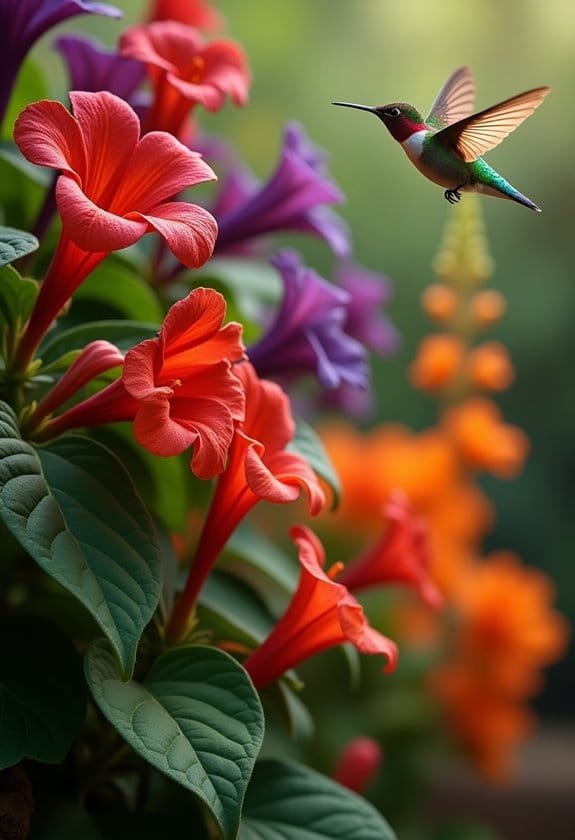
In caring for plants that attract hummingbirds, proper planting and maintenance are essential for peak growth and sustenance.
By selecting native, brightly colored, tubular flowers and guaranteeing they receive ample sunlight—approximately six to eight hours daily—gardeners set the stage for an inviting habitat. Adding native plants ensures a reliable nectar source that enhances the garden's appeal. For example, bluebells provide provisions when other blooms are scarce, making them an important nectar source for early-spring pollinators. Additionally, incorporating drought-tolerant plants like Large Thyme can support overall garden resilience while providing essential resources for local pollinators. Ensuring that the flowers thrive in well-draining soil is key to preventing root issues that can hinder growth.
Ongoing care, such as thoughtful watering practices and selective pruning, enhances blooming potential and secures a thriving ecosystem that benefits both flora and feathered visitors alike.
Planting Tips
When planning a garden that attracts hummingbirds, choosing the right plants is fundamental for their care and maintenance. Selecting vibrant plant colors, particularly shades of red, orange, and pink, will entice these delicate creatures. Tubular flowers, such as bee balm and various honeysuckle species, serve as excellent nectar sources, providing the sustenance hummingbirds require. Additionally, incorporating a mixture that includes 18 plant species for hummingbirds can create a beautiful and diverse garden.
Plant design plays an essential role; grouping three or more of the same species creates dense patches that maximize nectar availability. Utilizing trellises or trees not only supports climbing vines but also adds visual interest, enhancing your garden's aesthetic appeal. Including species like Vipers Bugloss can attract additional pollinators, further benefitting the ecosystem. Moreover, you can consider plants like White Clover that provide critical nectar sources for pollinators, helping to attract hummingbirds while supporting the wider ecosystem.
To guarantee a continuous supply of nectar throughout the hummingbird season, it's wise to select plants that bloom at different times. Additionally, hummingbirds exhibit excellent color vision, making vibrant colors more appealing to them.
Soil conditions greatly impact plant growth; aim for slightly acidic soil with a pH between 6 and 6.5. It's important to maintain moisture without allowing standing water, which threatens root health.
Additionally, when using containers, verify they've drainage holes and are filled with well-draining potting soil. By incorporating these strategies, gardeners can create inviting environments that support hummingbirds while enjoying their vibrant beauty.
Ongoing Care
Creating a thriving environment for hummingbirds involves not only plant selection but also ongoing care and maintenance. To guarantee these vibrant birds return year after year, gardeners should utilize effective pruning techniques and consider supplemental feeding.
First, it's crucial to provide adequate sun exposure, ideally 6-8 hours of full sunlight daily, to encourage prolific blooming. While hummingbird-attracting flowers can tolerate partial shade, ideal conditions lead to enhanced flower production. For instance, Flame Acanthus is a great option as it thrives in these sunny conditions while also attracting hummingbirds. Additionally, incorporating D. squarrosa, known as the firecracker plant, can significantly enhance the attractiveness of the garden due to its vibrant reddish-orange blooms. Planting other perennials like Great Burnet can further offer beneficial support for local pollinators, especially those that benefit from coastal habitats like rock samphire.
Watering should be done sparingly once plants are established. Initially, deep weekly watering helps settle the soil around roots, while supplemental watering during dry summers promotes abundant blooms.
Pruning is particularly beneficial; although not strictly necessary, a severe prune every few winters encourages vigorous growth. Lightly pruning in the fall maintains a neat form, allowing plants to flourish without unnecessary interference.
It's advisable to avoid over-fertilizing, as this can lead to increased moisture retention, which might harm sensitive roots. Instead, top-dressing with compost provides ample nutrients without the risks associated with commercial fertilizers.
Ultimately, these strategic care practices will create a flourishing habitat, drawing hummingbirds into the garden's embrace.
Suggested Companions
To enhance the appeal of a hummingbird garden, gardeners should incorporate a mix of native and adaptive companions that not only thrive alongside hummingbird-attracting flowers but also provide a diverse ecosystem for these energetic birds.
Companion planting with native species like Bee Balm, Coral Honeysuckle, and Cardinal Flower creates a harmonious environment, as these plants require similar growing conditions—moisture and sun balance—that facilitate mutual support. Bright colors, especially red, attract hummingbirds, making these companions even more appealing in a garden setup. Additionally, Comfrey's deep taproot system can help improve soil quality, benefiting nearby plants by enhancing nutrient availability.
For instance, Bee Balm, flourishing in USDA zones 4-9, attracts not just hummingbirds but also other crucial pollinators, promoting biodiversity and acting as primary pollinators for various native plants.
The Cardinal Flower, with its desire for ample moisture, flourishes in partially shaded areas, while durable Yarrow can thrive in sunny spots and withstand tough winters.
Additionally, Coral Honeysuckle acts as a non-invasive partner, ensuring healthy growth patterns that echo those of hummingbird mint.
Integrating these diverse species not only enriches the visual aspect of the garden but also guarantees a year-round nectar supply through staggered bloom times.
In addition, tall plants positioned behind shorter ones enhance visibility and accessibility for hummingbirds, thereby creating an inviting sanctuary that fosters their presence and importance.
Common Issues
Hummingbird gardens, while delightful, can encounter common issues that may hinder their success.
Although Wright's anisacanthus and similar plants face minimal pest and disease threats, gardeners should remain vigilant about overwatering and soil conditions, which can lead to yellowing foliage and reduced blooming.
Pests/Diseases
While enjoying the vibrant beauty of hummingbirds in their backyards, many bird enthusiasts face common challenges related to pests and diseases. Among the most disruptive nuisances are wasps, bees, and ants.
Wasps, particularly yellowjackets, can invade hummingbird feeders, competing for the sugar water meant for the birds. Fortunately, hummingbirds often locate feeding spots free from wasp interference. Meanwhile, ants frequently climb into feeders, where they may drown in the nectar. For effective pest management, applying sticky products like Tangle-foot to feeder poles can help deter these pesky invaders. Bee guards can also be useful in limiting insect access to the nectar without affecting hummingbirds. Additionally, ensuring proper feeder maintenance helps prevent fungal infections that can affect these delicate birds.
Disease prevention is paramount to ensuring the health of visiting hummingbirds. Poor feeder maintenance can result in dangerous fungal infections, such as candidiasis and aspergillosis, caused by mold development. Ingesting contaminated nectar can lead to significant health issues, including digestive disruption and lethargy.
Additionally, diseases like salmonellosis and avian poxvirus can arise from contaminated food sources, particularly in crowded feeder settings. The spread of these diseases underscores the importance of maintaining a clean and hygienic feeding environment, as well as avoiding the use of honey, which exacerbates fungal growth, hence safeguarding the delicate avian visitors.
Solutions
Maintaining a hummingbird-friendly environment involves addressing common issues that can arise in the garden. Gardeners must adopt effective planting strategies to guarantee that their landscape remains inviting to these delightful birds.
For instance, selecting tubular flowers like Bee Balm or Trumpet Vine, which cater to the long, slender beaks of hummingbirds, is crucial. Additionally, mass plantings of brightly colored flowers create a visual feast that attracts hummingbirds and guarantees abundant nectar sources throughout the blooming season. To optimize these plants, one should ascertain well-draining soil, as clogging can deter hummingbirds. It's essential to avoid overwatering, allowing the soil to dry out between waterings—this simple practice can safeguard plant health and nectar production. Including diverse native plants as part of your garden design enhances the habitat by providing essential nutrients and attracting beneficial insects. Incorporating nectar-rich flowers like the cardinal flower can significantly enhance a garden's attractiveness to hummingbirds.
Pruning is a key maintenance task; removing no more than one-third of the plant's mass every one to two years allows for robust growth without sacrificing bloom frequency.
Incorporating native plants not only supports local ecosystems but also provides continuous nectar sources. Gardeners can create a thriving environment by combining these strategies, ultimately fostering a sanctuary that delights hummingbirds and inspires admiration from all who witness their beauty.
Summary
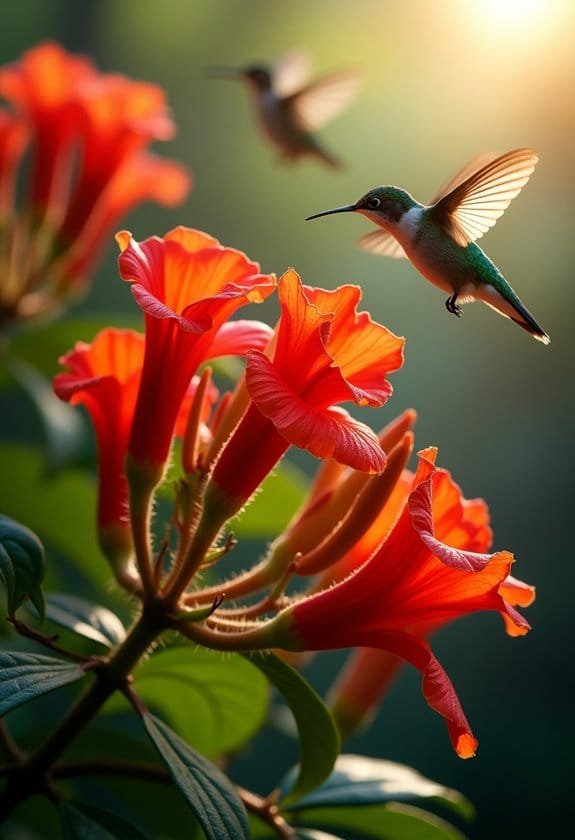
Attracting hummingbirds to a garden can be achieved by selecting the right flowers that meet their specific preferences. Understanding hummingbird habits reveals that these remarkable creatures are drawn primarily to tubular-shaped flowers, which allow convenient access to nectar sources.
Trumpet-shaped variations, such as Hollyhocks and Trumpet Creeper, serve as prime examples of the favored floral structures. Color also plays a significant role in attracting these avian visitors; brilliant reds and oranges are standout choices, although hues of purple, pink, and blue can still entice them.
Flowers with high nectar content, like Cuphea and Agastache, support hummingbirds' high metabolism, facilitating their return frequently for sustenance. Geographic and climatic considerations further influence plant selection.
For instance, East Coast gardeners can focus on plants like the Cardinal Flower, while Western regions might opt for Wyoming paintbrush. Ultimately, cultivating a diverse array of plants that thrive in full sun and various USDA zones not only enhances garden aesthetics but also guarantees a steady congregation of hummingbirds, enriching the ecosystem and providing an awe-inspiring display of nature's beauty.
